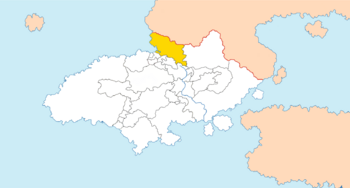Bessen-Katzenelm
Kingdom of Bessen-Katzenelm Königreich Bessen-Katzenelm (Alemannisch) | |
|---|---|
 Bessen-Katzenelm within Dolchland | |
| Status | Consitituent state of Dolchland |
| Location | Dolchland |
| Capital | Heinfeldes |
| Official languages | Bessisch Alemannisch |
| Demonym(s) | Besser |
| Government | |
• King | Ernest II |
• Minister-President | Rupert von Heifl |
| Legislature | Landtag |
| Grand Estates | |
| House of the Commons | |
| Establishment | |
• Formation of the archaic Kingdom of Besse | 647 |
• Dissolution of the Kingdom | 782 |
• Formation of the Margraviate of Katzenelm | 893 |
• Formation of the Duchy of Heinfeldes-Besse | 1044 |
• Unification of Bessen-Katzenelm | 1482 |
• Reformation of the Kingdom | 1701 |
The Kingdom of Bessen-Katzenelm (Alemannisch: Königreich Bessen-Katzenelm), commonly referred to as Bessen-Katzenelm or, informally, the Bessemark, is a semi-independent constituent state of the Empire of Dolchland. Located in an area historically referred to as the Bessemark, the Kingdom controls the whole area, and consistently comes to blows with neighbouring Wurveria. Bessen-Katzenelm lies on the border with Velaheria to the north, and is internally bordered the Kingdom of Wurveria to the east, Westervark to the south, and Tale-Schüssel, Tale-Flußstadt and Ersau and Kirchmarkt and Teilen to the southwest.
What would become the Bessemark region arose from much of the land of the archaic Kingdom of Bessen, an independent Kingdom from 647 to 782. Upon the dissolution of the Kingdom at the hands of a rising ($KINGDOM/EMPIRE), Bessen became a mess of tiny successor principalities. Some of these grew to prominence, most notably the Margraviate of Katzenelm, formed on the furthest borders of the region, and the Duchy of Heinfeldes-Besse around the city of Heinfeldes. With the union of these two states, the groundwork for a reforged Kingdom was laid. In 1701, the Kingdom was declared, with the Emperor's assent, with the monarchs of Bessen-Katzenelm owing essentially a debt of gratitude to the Emperors. Bessen-Katzenelm fought in the War of the Habstrian Succession, fighting mostly in the Drei Flüsse theatre against Lower Streckeburg, where the fighting drew to a stalemate.
Bessen-Katzenelm holds a great deal of sway over the modern Drei Flüsse region, with most of the former Großtal acknowledging Besser primacy in the region and Upper Streckeburg sharing the same dynasty as the kingdom. Further afield, Witternen also shares a close relationship to Bessen-Katzenelm due to their dynastic ties. Bessen-Katzenelm possesses a unique northern culture that has influence over other cultures in the area, and a populace who are proud of their heritage and the ancient nature of their Kingdom. The Kingdom possesses a sizeable economy, and contributes greatly to the wider Dolchlandic military, economy and cultural identity.
History
Flag and coat of arms
Flag
The flag of Bessen-Katzenelm is a simple bicolour of white and blue, with the Royal Crown of Bessen-Katzenelm in the upper fly. White and blue have been associated with the royal traditions of Bessen due to its long association with the Theoderingian dynasty, who ruled the ancient Kingdom of Besse.
Coat of Arms
Bessen-Katzenelm uses, as its official coat of arms, the arms of its ruling house, the House of Gloschlick-Berta. It shares a similar style of Coat of Arms to the other Gloschlick-Berta state, Witternen, though their arms do have some differences. The arms of Bessen-Katzenelm consist of the following:
- The arms of Gloschlick: at the dexter chief, party per cross argent and sable, a cross quarterly gules and or. This represents the House of Gloschlick.
- The arms of Katzenelm: at the sinister chief, argent, an eagle sable, a chief gules, upon which an axe argent. This represents the House of Berta as Margraves of Katzenelm.
- The arms of Witternen: at the dexter base, or, an eagle sable, a bordure gyronny gules and argent. This represents the House of Witternen.
- The arms of Heinfeldes-Besse: at the sinister base, azure, a lion argent, on the bordure 11 roses. This represents the House of Heinfeldes-Besse, as a union of the earlier symbols of the Theoderingians and the House of Heinfeldes.
- The Royal Inescutcheon: argent, a lion bleu-celeste. This is believed to have been a symbol originally of the Theoderingians, though has since become a symbol of the Kingship in Bessen-Katzenelm.
- The Defenders' Crown: Though arguably superseded by the Royal Crown, Bessen-Katzenelm has long been allowed the use of the Defenders' Crown, a crown symbolising their rights as former margraves of Katzenelm, and their theoretical right to field an army for the defence of the Empire.

